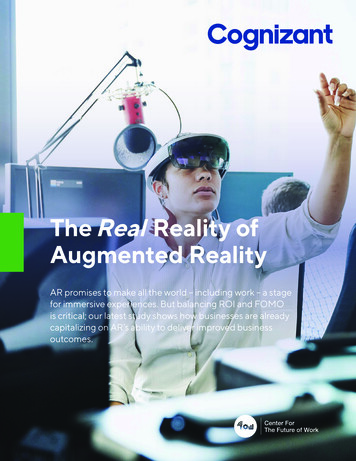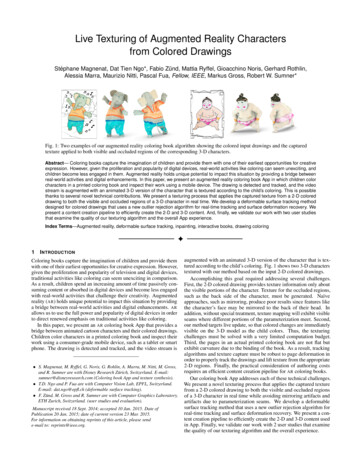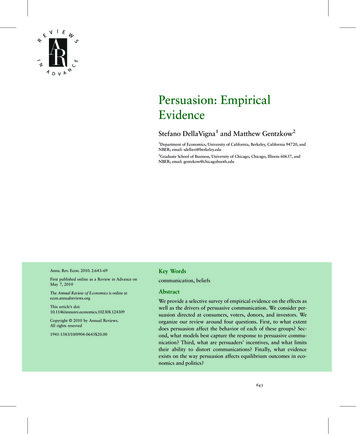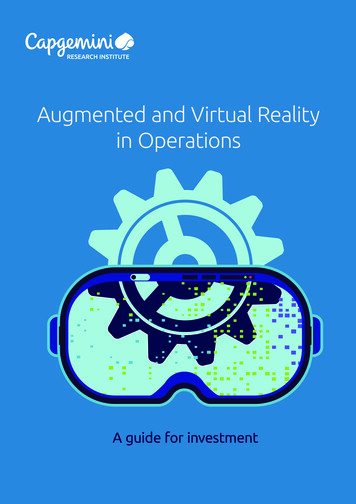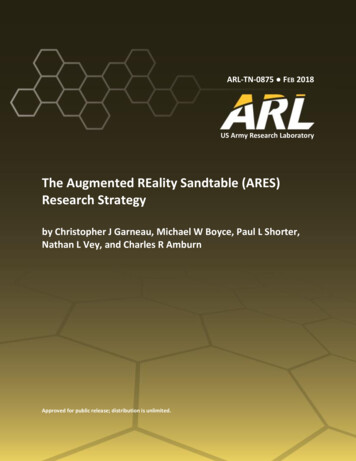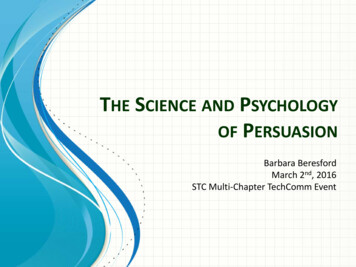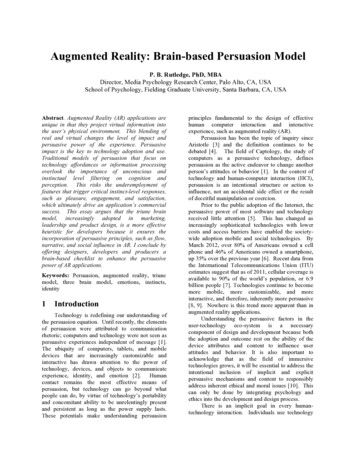
Transcription
Augmented Reality: Brain-based Persuasion ModelP. B. Rutledge, PhD, MBADirector, Media Psychology Research Center, Palo Alto, CA, USASchool of Psychology, Fielding Graduate University, Santa Barbara, CA, USAAbstract. Augmented Reality (AR) applications areunique in that they project virtual information intothe user’s physical environment. This blending ofreal and virtual changes the level of impact andpersuasive power of the experience. Persuasiveimpact is the key to technology adoption and use.Traditional models of persuasion that focus ontechnology affordances or information processingoverlook the importance of unconscious andinstinctual level filtering on cognition andperception. This risks the underemployment offeatures that trigger critical instinct-level responses,such as pleasure, engagement, and satisfaction,which ultimately drive an application’s commercialsuccess. This essay argues that the triune brainmodel, increasingly adopted in marketing,leadership and product design, is a more effectiveheuristic for developers because it ensures theincorporation of persuasive principles, such as flow,narrative, and social influence in AR. I conclude byoffering designers, developers and producers abrain-based checklist to enhance the persuasivepower of AR applications.Keywords: Persuasion, augmented reality, triunemodel, three brain model, emotions, instincts,identity1IntroductionTechnology is redefining our understanding ofthe persuasion equation. Until recently, the elementsof persuasion were attributed to communicationrhetoric; computers and technology were not seen aspersuasive experiences independent of message [1].The ubiquity of computers, tablets, and mobiledevices that are increasingly customizable andinteractive has drawn attention to the power oftechnology, devices, and objects to communicateexperience, identity, and emotion [2].Humancontact remains the most effective means ofpersuasion, but technology can go beyond whatpeople can do, by virtue of technology’s portabilityand concomitant ability to be unrelentingly presentand persistent as long as the power supply lasts.These potentials make understanding persuasionprinciples fundamental to the design of effectivehuman computer interaction and interactiveexperience, such as augmented reality (AR).Persuasion has been the topic of inquiry sinceAristotle [3] and the definition continues to bedebated [4]. The field of Captology, the study ofcomputers as a persuasive technology, definespersuasion as the active endeavor to change anotherperson’s attitudes or behavior [1]. In the context oftechnology and human-computer interaction (HCI),persuasion is an intentional structure or action toinfluence, not an accidental side effect or the resultof deceitful manipulation or coercion.Prior to the public adoption of the Internet, thepersuasive power of most software and technologyreceived little attention [5]. This has changed asincreasingly sophisticated technologies with lowercosts and access barriers have enabled the societywide adoption mobile and social technologies. ByMarch 2012, over 80% of Americans owned a cellphone and 46% of Americans owned a smartphone,up 35% over the previous year [6]. Recent data fromthe International Telecommunications Union (ITU)estimates suggest that as of 2011, cellular coverage isavailable to 90% of the world’s population, or 6.9billion people [7]. Technologies continue to becomemore mobile, more customizable, and moreinteractive, and therefore, inherently more persuasive[8, 9]. Nowhere is this trend more apparent than inaugmented reality applications.Understanding the persuasive factors in theuser-technology eco-system is a necessarycomponent of design and development because boththe adoption and outcome rest on the ability of thedevice attributes and content to influence userattitudes and behavior. It is also important toacknowledge that as the field of immersivetechnologies grows, it will be essential to address theintentional inclusion of implicit and explicitpersuasive mechanisms and content to responsiblyaddress inherent ethical and moral issues [10]. Thiscan only be done by integrating psychology andethics into the development and design process.There is an implicit goal in every humantechnology interaction. Individuals use technology
to satisfy their needs; technology is designed tofacilitate human behavior and goals. The implicitgoals in persuasive design can be subtle, such asdesign structures that help people to navigateeffectively on a website, or overtly purposeful, suchas software or device-supported time management.Users also experience the interaction holistically,often independent of the goals, accompanied by anemotional response. A successful and rewardingexperience reflects positively on the user’s sense ofself-confidence and self-efficacy, increasing theirself-image. This in turn influences the user’s attitudeand liking for the application and their willingness torecommend and reuse. A disruptive, frustrating, orineffective interaction challenges the user’s selfcompetence. This ‘attack’ on the ego createscognitive dissonance that is quickly resolved byrejecting and publicly criticizing the application [11,12]. Psychologically positive user experiences createan upward spiral of mutually reinforcing rewardingexperiences. Negative user experiences don’t spiral;they crash.Growing user control and expandingtechnological capabilities that allow the delivery ofrich content and social connectivity increase thepotential for persuasive experiences. Accordingly,AR applications are highly persuasive technologies,as they enables the on-demand addition of virtualinformation to a user’s sensory perceptions andcreate opportunities for immersion, simulation, andinteraction [13, 14].2Brain-based model of persuasionThe critical component for persuasion isengagement—the ability to attract and keepattention—no matter what the technology. Allphysical and psychological experience, including ourability to notice and attend, is first filtered and thenconstructed by subconscious sensory processingsystems [15], therefore persuasion, as the outcome ofattention, starts in the brain [16, 17].2.1The triune model of the brainIn the 1960s, the neuroscientist and physicianPaul MacLean proposed the triune, or three brainhypothesis [18] that has been increasingly adoptedby the fields of marketing (‘neuromarketing’),design, and leadership [19-23] . While simplisticrelative to the physical complexity of the humanbrain, this model highlights instinct-, emotion- andidentity-driven motivations and provides an accurateand useful framework for understanding andtriggering human response to different stimuli andexperiences [24-27]. I suggest that the three-brainmodel is a powerful approach for understanding thepersuasiveness of AR, because AR applicationsintegrate virtual information with direct multisensory experience and create multiple conscious andunconscious entry points of engagement andinfluence.2.1.1Unconscious and conscious thought:instincts, emotions and identityThe human brain evolved new capabilities overthe millennia by layering functional areas on to itsphysical mass.The result is a composite ofevolutionary progress [28]. MacLean’s three-brainmodel links the differences in the behaviors fromeach major functional area to the evolution of animallife, arguing that the brain effectively has three partsthat are representative of their stage of evolution: thereptilian or old brain, the emotional center ormammalian brain, and the neocortex or the newbrain, as illustrated in Figure 1 [29].The most primitive sections of the brain, thereptilian brain and the mammalian brain, operatesubconsciously. The reptilian brain, comprised ofthe brain stem, mid brain and basal ganglia, is theoldest and most primitive. It controls instinctivephysical behaviors, such as breathing, as well assurvival-related responses such as aggression andfear.Although primitive, the reptilian brain ishighly sensitive to proximity, self-relevance, reward,and threat. It continually monitors the environmentfor potential danger by assessing change, andidentifying patterns and familiarity.The emotions were the next functions todevelop in the brain. The mammalian brain is theemotional center located in the limbic system, whichincludes the amygdala, hippocampus, hypothalamusand other structures. It mediates social emotionssuch as attachment, liking, love, pride, guilt, shame,and scorn as well as behaviors related to maternalnurturing and play [30-32]. Where the reptilian brainresponds to primitive, physical-survival instincts, themammalian brain supports the survival of theorganism through socially-based emotional responseand the drive for social connection. Together, thereptilian and mammalian brains are responsible forinstinctive responses that activate multiple physicaland emotional systems for quick reactions, such asfight or flight or protecting offspring [33].The third part of the three-brain model is theneocortex. From an evolutionary perspective, theneocortex is the newest part of the brain and is whatdistinguishes humans from other mammals [34]. It isthe center for conscious thought, such as conceptual,higher order learning, language, problem-solving,sequential thought such as planning, and the abilityto have conscious awareness of a ‘self’ and identity
that are central to concepts such as self-esteem, selfefficacy, and agency [17].Figure 1. Triune Brain Modelways where systemic processing is attended andintentional and heuristic processing involves patternsand cues that unconsciously influence a decision.The Elaboration Likelihood Model (ELM) similarlyproposes multiple routes for message processing [42,43]. In the ELM model, commonly applied inmarketing research, messages received in the centralroute receive careful scrutiny and evaluation, wheremessages received in the peripheral route are notconsciously processed but may exercise significantinfluence in unpredictable ways [44].2.2These distinctions in functionality represent thedichotomy between primitive brains’ unconsciousholistic cognition derived from sensations, bodilysymptoms, drive and emotions [35], and the ‘new’brain’s conscious analytical, linear processing ofinformation. The unconscious brain speaks thelanguage of image and feelings and can experienceonly the present.By contrast, the neocortexconsciously processes information as what BertrandRussell famously described as ‘knowledge bydescription’ versus ‘knowledge by acquaintance,’ orknowledge that results from judgment andinterpretation rather than from direct sensoryawareness [36]. This is a relevant distinction for ARas technology becomes more experiential.2.1.2Theoretical links: Brains as informationprocessorsThe triune brain theory can be mapped toseveral psychological theories of informationprocessing and persuasion. The unconscious versusconscious processing of information in the triunetheory is analogous to William James’ [37] theory ofawareness as a composite of the focused attention, ornucleus, and the unattended awareness, or fringe.The preconscious processing of the reptilian braincan also be equated with Daniel Schacter’s [38]implicit knowledge — things we know that are not inawareness — and with Ulric Neisser’s [39]investigation of attended and preattended content. Itcan also be seen as the difference between directperception and information ‘pickup’ as applied tovisual perception by James J. Gibson [40].Comparably, dual pathways theorist Chaiken’s[41] Heuristic-Systematic model posits that peopleprocess information in both systemic and heuristicThe benefit of the brain perspectiveThe triune brain model, unlike dual pathwayspersuasion models, places the emphasis on therelative influence of the conscious/direct versusunconscious/peripheral pathways to persuasiveprocesses. The triune model stresses the dominanceof the reptilian brain in information filtering andsubsequent research has supported this contention,demonstrating that initial preconscious processing isresponsible for as much as 95% of decision-making[24, 45]. Thanks to the philosopher Descartes, weare culturally predisposed to think of the brain andbody as separate [17, 46]. There is ample evidence,however, that thoughts, emotions and the body aremutually influential [16]. Advances in neuroscienceand brain scan technologies, however, support theapplication of the triune brain model to understandhow motivation, trust, and attitude change canactivate the brain. Researchers have applied fMRI(functional Magnetic Resonance Imaging) andmeasured the level of the reward systemneurotransmitters, such as oxytocin, to track the waythe brain receives and responds to different messagesand images. They have been able to track positiveemotional responses to stimuli such as puppies,babies and even Twitter retweets [21, 30, 47]. Theunconscious brain response translates into manydaily experiences. Studies show, for example, thatstress interferes with sleep and digestion, petting adog lowers blood pressure [48], and when someonesmiles at another person, mirror neurons trigger asmile response that is accompanied by a chemicalpay-off through dopaminergic reward systems inboth people [49, 50].Psychologist Jonathan Haidt [51] provides auseful visual metaphor of an elephant and a rider toillustrate the imbalance of power between the brain’sinstinctive responses as the giant elephant and theconscious brain’s abilities as the small rider tocontrol attitudes and behavior. While the separatesystems of the brain are inextricably linked throughthe continuous communication of neurotransmitters,the strength of instinctual processing at the
unconscious level dictates most decisions and actions[34].No matter their origin, persuasive effectsoperate at multiple levels simultaneously, frommotivating initial product engagement and ease ofuse (e.g., can an individual easily and effectively usea device?) to specific targeted behavior or attitudechange (e.g., will this help the individual achieve agoal, such as an eating healthier?). Fogg makes thedistinction between macro level persuasion that has adistinct persuasion-based outcome goal, such assmoking cessation, compared to the micro levelpersuasion that is inherent in usability design thatincreases productivity and enhances the subjectiveexperience, such as self-efficacy, of the user [1]. Atany level, the goal or desired outcome of anapplication is for an individual to process apersuasive communication so that it becomesinternalized into his/her core belief system to achievean attitude or behavioral change at some level. Inother words, the AR experience must be immersiveand seamless. For this to happen, the AR applicationmust arouse the primitive instincts in the reptilianbrain. Based on the three-brain model, this can onlyhappen if it the application is clearly relevant to theuser, solves a problem, offers a reward or poses athreat.3ARAR uses technology to augment real worldenvironments by overlaying virtual information, ondemand, that expand the user’s sensory perceptionswith the three-dimensional registration andintegration of digital data [52]. The persuasivepower of AR lies in its ability to create immediacyand relevance by shifting the loci of control andinteraction through situated simulations within thecontrol and environment of the user. Combiningvisual simulation of data in situ creates and enhancesmeaning and engagement [53]. The on-demand,self-generation of the experience promotes positiveaffect. The threat or reward is, to some degree,content dependent, however, the act of generating thevirtual overlay creates a micro persuasive effect ofincreased self-efficacy for the user and triggers areward response in the brain at more than one level[54].The AR experience, once cumbersome andcostly, is now increasingly accessible at little or nocosts to nonexpert users through applications onsmartphones and computers. Companies such asTotal Immersion1 and Metaio2 are racing to develop12www.t-immersion.comwww.metaio.comAR platforms and applications for customer demandto incorporate AR experience into everything fromproduct visualization and marketing [55], therapeuticinterventions [56], education [57], tourism [58], toAR events, games and entertainment [59, 60]. Thecontinuing development of increasingly robustmobile devices has untethered AR technology,increasing mobility and the sense of user controlthrough enabled compass functions and GPS-basedand object recognition-based experiences3.In contrast to virtual reality, whose massadoption is limited by its relatively intensiveequipment and immersive requirements and frequentindividual resistance to ‘simulated reality’ [61], ARis additive, layering virtual information over the realworld, allowing it to be displayed in a spatial context[62], creating less cognitive dissonance and,therefore, easier adoption. The combination ofmobility and cognitive ease, along with ce’4 predicts that the rising trend AR usewill continue. As AR applications become widelyapplied, it will be increasingly important tounderstand the way the brain engages with ARapplications to effectively and responsibly integratepersuasive design experiences.4Applying brain-based guidelinesThe triune brain model suggests three mainareas of focus for targeting design and analysis, onefor each level of the brain: instinctual responses,emotional responses, and identity responses. Theycan function independently, but, given the interrelatedness of the brain, are more often simultaneousand mutually reinforcing.As described above, the primitive reptilianbrain is only focused on information that directlyimpacts survival: immediate relevance followed byreward or threat.4.1Relevance and rewardRecognition and immediacy determine whetherinformation in the environment will trigger theattention of the primitive brain. Human brains arewired to notice indicators of danger; this includeschange and contrast, things that are new or unusual,emotionally as well as perceptually. As the reptilian3www.layar.comPersonal reflection from Transmedia Hollywood3Conference, Los Angeles, CA April 3, 2012 asrepeated theme across full day of panels made up ofmultiple industries: marketers, media producers,media scholars, and entertainment professionals.4
brain scans the environment for patterns andmovement, the appearance of an AR simulation withrich media produce novelty and change, enhanceattention and physical arousal, and make deliveredinformation more salient, memorable, and actionable[21].Once information is attended, cognitiveprocessing continues by comparing new informationto previous experience to determine the level ofreward or threat. The more familiar the information,the less likely it is to trigger a threat response, andthe more likely the brain is to interpret the stimuli aspositive or being of value. Content is perceived asself-referent and suggests similarity in addition torelevance delivers increased perception of value [63].Historically, our likelihood of survival was increasedby affiliating with those things most familiar to us,from people to environments. The ability to selfreference and self-identify leads to a favorableevaluation of a product or experience no matter whatthe quality of content logic or information.Similarity increases relevance and positiveperceptions, or ‘liking’ [13, 64, 65]AR applications are on demand, enhancing thesense of control (safety) and personal investment(identity) [66]. The content is, by definition, selfrelevant because it is pulled to the user on demand,not pushed as in traditional advertising. Useful andaccurate content provides a solution to a problem orquestion, creating a sense of safety and enhancedself-efficacy. Additional preferences give the usercontrol over how the information is displayed. Theuser has choice over exactly where, with whom, andon what device to activate and experience theinformation. The sensation of success and control bythe reptilian brain is processed as reward and triggerspositive emotions (pride, happiness) through thedopamine system [67] and is translated by theconscious brain as successful, personal validationand efficacy (identity) [68, 69].4.2EmotionAR has the ability to tap multiple levels ofemotion by linking the affect in present experienceswith triggers from virtual experiences.Visualrepresentations are the most effective ways to triggeremotions. Over 50% of the cerebral cortex isdevoted to visual processing [70]. The visual systemevolved with the haptic nervous system and,therefore, a large proportion of tactile signals triggerthe visual cortex [71, 72]. Virtual responses activatethe same neural networks as real experiences,recalling all associated sensory and emotionalmemories, thus virtual overlays will meaningfullyenhance emotional and somatic experience [70]4.3Social connectionSocial needs are some of the most powerfulforces in persuasion. Humans are neurologicallywired to seek social attachment [73]; they are acutelysensitive to social perceptions, inclusion, acceptanceand rejection [74].The pattern-seeking reptilian brain looks formeaning in the environment and is particularlyattuned to the arrangement of shapes suggestinghuman faces.This socially-oriented biologicalpredisposition also causes humans to attributepersonalities and motivations to others, both humansand nonhuman, such as animals and objects [75].Consequently, people are not only able to see humanfaces in everything from the moon to potato chipsand attribute complex emotions to pets, but the act ofanthropomorphizing even inanimate objects, such ascomputer devices creates a genuine emotionalattachment and enhances the persuasive effect [76].The human predisposition to attribute humancharacteristics to objects and devices suggests thatAR applications can leverage social rules anddynamics when they successfully reinforce humanattributes and interactions, such as the socialconventions of praise or support enhanced by theproximity and blended reality of content projectedinto the user’s physical space. The reptilian andmammalian brain responses, biologically driven toseek affiliation, interpret these as genuine socialbehaviors and social exchange, activating thepowerful persuasive effects of the rule of reciprocity,that we must return favors to others, and socialvalidation, that we are valued by others in our group[13].The mobility of AR also allows forcollaboration among users locally and virtually.Connected to social networks, AR applications canleverage the impact of social proof, that people areinfluenced by what others around them do, andaffiliation or social identity, that we are similar toothers we value. Researchers have showncorrelations between behavior change and neuralactivity in regions involved in monitoring socialperceptions and have affirmed the role of socialfactors in the persuasion process [77, 78]. Behaviorchange is correlated with increased neural activity inareas involved in memory, attention, visual imagery,motor execution and imitation and affectiveexperience. This is consistent with theories of sociallearning and persuasion suggesting that behaviorchange can result in social norms into self-concept[77], underscoring the roles of safety, connection,emotion and identity represented by the three braintheory.
4.4IdentityThe new brain categorizes and interprets theinformation it receives from the unconscious brainsin order to commit it to memory for future recall. ARcan have powerful impact on conscious cognitionthrough the psychological experiences that enhanceidentity: self-efficacy, competence and validation[11, 79]. Successful experiences retrieving andmanipulating data and being able to act successfuland pleasurably result in goal achievements. Senseof reward can be minor, such as ease of use orfinding a local coffee shop, to larger milestones suchas achieving weight loss. The positive achievementswill be reflected both in self-image and in productappreciation and loyalty [12].4.5Persuasion using narrativeThe most powerful method for coherentlyengaging all levels of the brain is through narrative.‘Story’ may sound unscientific, but stories (ornarratives) are how the human brain organizesinformation.Stories create authentic humanexperiences and they are how humans have passedonline culture, knowledge and social norms fromgeneration to generation throughout history.Narratives leap frog the individual attributes oftechnology by creating a holistic experience thatengages the brain at all levels: instinctive, emotionaland identity [80, 81]. The experience of narrativeimmersion inhibits cognitive challenge and increasesthe potential for persuasive influence. AR isinherently a narrative experience because, beyondthe content, the act of engagement brings AR into theuser’s reality and personal story.Stories take place in the imagination but theyare a multisensory experience. The brain processesimagined experiences using the same physical andneural mechanism as real ones, creating genuineemotions and sense of place in AR applications [82].Cognitive psychologists use terms such asschemas, scripts, cognitive maps, mental models,metaphors, and narratives to describe the processesindividuals use, consciously and unconsciously, toconstruct meaning and integrate our experience so itcan be stored in memory [e.g., 83, 84, 85]. In orderfor something to be committed to memory, it has tohave context in a linear structure that can be enrichedand linked with multisensory information, forexample, ‘A happened, then B,’ or ‘C happened withD because of E.’ Isolated facts are not retained;stories are the mnemonics for memory retention,creating neural networks for future recall andreactivation.The creation of a narrative allows an individualto find the shared meaning (relevance), connection(emotion) and step into an experience as a character(identity).This is what creates an immersiveexperience and enable the ability to feel empathy andenvision new opportunities for ourselves, whilesimultaneously reducing negative cognitive responseand increasing positive affect [86].Narrative transportation theory describespersuasion as a function of an individual’s ability toprocess information and messaging in the context ofnarrative [87] that also supports self-referencing.Self-referent processing is the cognitive process bywhich each person compares new information tohis/her existing memories, beliefs, feelings, andexperiences in order to give it context and meaning[64]. When information is salient, i.e. it can belinked to self-referent meanings, it has been shown toenhance learning, memory, and recall [e.g., 88].AR is the ultimate ‘product placement’ becauseit links real life with virtual objects and stories [63].Persuasion research has primarily focused onconsumer processing of rhetorical product messaging(ads) rather than examine the narratives within whichthe placements occur. With narrative transportationand AR, however, the user has the opportunity tolose him/herself in story with the product as acompanion on the journey [89-91]. Green and Brockargue that mental immersion is persuasive because itleads to disinhibiting of the critical thinkingfunctions and heighten affective responses [92, 93].In other words, it activates and engages the primitivebrain levels that are driving decision-making.Escalas confirmed this where audience memberswere able to imagine themselves as the ‘star’ of thenarrative [14]. Heightened affective responses led tomore favorable evaluation of the experience, ad,brand or product.4.6Persuasion and optimal experienceThe triune brain model can also be used tocontextualize persuasion in the theory of optimalexperience as defined by Csikszentmihalyi in histheory of Flow [94]. Flow is the state of completeengagement where the challenge of an activitymatches the skills of the user at the level that requireseffort and concentration yet is within the boundariesof the user’s capabilities [see also, 95]. This balancecreates a zone of “flow” that increases opportunitiesfor persuasion by inhibiting cognitive opposition andcreating positive affect.
Figure 2: Brain-Based Model View of Flowfor optimal user experience, see Rutledge and Neal,2012). Designing for the brain means following theneurological processing path in order to align designdecisions with innate biological priorities andattention hurdles. In other words, start with old brainconsiderations.5.1Maintaining flow requires balancing thechallenge of an activity with the requisite skill levelfor successful accomplishment, as shown in Figure 2.Imbalance results in either boredom or anxiety anddisrupts the feelings of flow. Applying the triunebrain model lets us conceptualize the flow process asa primitive balance between threat and reward. Thechallenge of an activity must be difficult enough toachieve arousal to generate attention andconcentration of the reptilian brain without escalatingarousal to a level that is perceived as a threat tosurvival. The skill and challenge equilibrium mustwork within the zone that enhances self-efficacy totrigger the dopaminergic reward system and bolstersidentity and self-esteem at the conscious level.Challenges that overwhelm skills threaten identityand self-competence, triggering the threat responseunconsciously which is interpreted as dislike andfrustration, consciously [96].Unconscious negative experiences create acognitive challenge to individual identity. Thiscognitive dissonance is resolved by preserving apositive sense of identity and attributing the negativeexperience to the activity, application or experience[97]. The flow state can also be equated to narrativeimmersion with similar impact on persuasive effects[98, 99].5Implications for design anddevelopmentThe application of the triune brain model ofpersuasion has implications for design decisionsthroughout the development process as
Augmented Reality: Brain-based Persuasion Model P. B. Rutledge, PhD, MBA Director, Media Psychology Research Center, Palo Alto, CA, USA School of Psychology, Fielding Graduate University, Santa Barbara, CA, USA Abstract. Augmented Reality (AR) applications are unique in that they project
